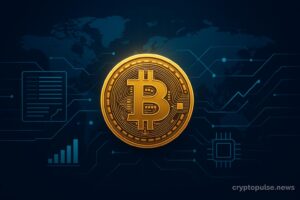What Is Tokenization and How It Transforms Finance
Tokenization converts real-world and digital assets into secure blockchain-based tokens, enabling faster settlement, global accessibility, and new financial opportunities across modern markets.
Introduction
Tokenization has rapidly evolved from a niche blockchain concept into one of the most transformative trends reshaping global finance. At its core, tokenization refers to the process of converting ownership rights to an asset—whether real estate, government bonds, commodities, or digital goods—into a digital token stored on a blockchain. This shift enables assets that were historically illiquid, slow to transfer, or restricted to elite investors to become instantly transferable, programmable, and globally tradeable.
As central banks, asset managers, and major corporations adopt blockchain infrastructure, tokenization is emerging as the primary bridge between traditional finance and digital asset ecosystems. Tokenized U.S. Treasury bills alone grew into a multi-billion-dollar market by 2024–2025, driven by demand for 24/7 settlement, lower operational costs, and on-chain transparency. Simultaneously, real estate, gold, funds, and supply-chain assets are being digitized at an accelerating pace, solidifying tokenization as a foundational element of future financial systems.
For everyday users, tokenization opens access to high-value markets that previously required large capital or intermediaries. For institutions, it delivers automation, security, efficiency, and reduced counterparty risk. As both worlds converge, tokenization is becoming a universal framework for how value is created, stored, and transferred in a digitally interconnected economy.
What Is Tokenization? A Simple Explanation
Tokenization is the process of turning ownership rights to an asset into a digital token recorded on a blockchain. Each token represents a specific claim—such as a share in a property, a portion of a Treasury bill, or a unit of gold—secured by cryptography and immutable distributed ledger records.
To avoid confusion, it helps to differentiate tokenization from other digital processes:
- Digitization – converting information into digital form (e.g., scanning a document).
- Tokenization – converting ownership rights to an asset into a transferable, programmable blockchain-based token.
A blockchain is a decentralized digital ledger that records transactions securely and transparently across a distributed network of computers. This structure prevents tampering, ensures integrity, and allows anyone to verify transactions independently. The first and most widely recognized example of this technology is the Bitcoin network, which proved that digital value can be stored and transferred securely without intermediaries.
Because tokenization leverages blockchain technology, it enables high transparency, secure ownership, global accessibility, and fast, low-cost transfers, which are not possible with traditional systems.
Types of Tokenization
Fungible Tokenization
Fungible tokens are identical and interchangeable. They are suited for assets with uniform value per unit.
Examples include:
- Tokenized U.S. Treasury bills
- Cash-equivalent tokens and bank deposit tokens
- Fiat-pegged stablecoins
- Gold-backed tokens such as PAXG or XAUT
Because each token carries exactly the same value, fungible tokenization is ideal for financial instruments, fixed-income products, and commodities.
Non-Fungible Tokenization (NFTs)
Non-fungible tokens represent unique assets that require individualized tracking.
Examples include:
- Property deeds and land titles
- Intellectual property, patents, and certificates
- Tokenized identity credentials
- Fine art and collectibles
The long-term value of NFTs lies not in digital pictures, but in representing unique physical or digital assets with verifiable authenticity and ownership.
How Tokenization Works (Step-by-Step)
1. Asset Identification
The asset to be tokenized is selected—real estate, government bonds, commodities, or digital assets.
2. Legal Structuring
A legal wrapper defines:
- ownership rights
- investor protections
- compliance requirements
- transfer and redemption rules
Clear legal frameworks ensure that token holders have real, enforceable rights to the underlying asset.
3. Token Creation (Minting)
Smart contracts are deployed to create tokens representing the asset.
A smart contract is a self-executing program stored on a blockchain that automatically enforces rules, manages ownership, controls token supply, and processes transactions without intermediaries.
4. Custody & Storage of the Underlying Asset
The physical or financial asset is placed with a trusted custodian or regulated entity.
The value of the token depends on transparent and secure management of the underlying asset.
5. Issuance & Trading
Tokens can be purchased, transferred, or traded via:
- regulated security token exchanges
- institutional on-chain platforms
- decentralized marketplaces
- private peer-to-peer transfers
Each transfer is recorded on-chain, creating transparent, auditable ownership history.
Real-World Examples of Tokenization in Action
Tokenized Government Bonds & Treasury Bills
One of the fastest-growing sectors in blockchain finance is tokenized fixed-income products.
Notable examples include:
- BlackRock’s BUIDL fund, representing tokenized U.S. Treasury collateral
- Franklin Templeton’s FOBXX, among the first fully on-chain money market funds
- Tokenized T-bills issued on public networks such as Ethereum and Stellar
These instruments offer:
- 24/7 global settlement
- Lower counterparty and operational risk
- High transparency for regulators and investors
Real Estate Tokenization
Real estate is traditionally illiquid. Tokenization enables fractional ownership and global access.
Use cases:
- Tokenized rental properties
- Commercial real estate shares
- On-chain distribution of rental income
- Digital REIT-like structures
Tokenization dramatically lowers minimum investment thresholds and increases liquidity.
Commodity Tokenization
Commodities are natural candidates for tokenization.
Examples:
- Gold-backed tokens redeemable for physical gold
- Digitized silver and industrial metals
- Tokenized agricultural stockpiles
These products allow investors to hold commodities without managing physical storage.
Tokenized Funds & ETFs
Asset managers are also experimenting with on-chain versions of traditional ETFs, where fund shares are issued as digital tokens, enabling faster settlement and broader global access compared to conventional exchange-traded products.
Benefits include:
- automated dividend distribution
- global access
- built-in compliance and investor management
Corporate & Business Tokenization
Companies are adopting tokenization for:
- tokenized invoices
- tokenized cash flows and revenue rights
- supply-chain tracking
- carbon credit systems
- tokenized credit products
These models streamline operations and open new financing opportunities.
Why Tokenization Matters for Everyday Users
Lower Entry Barriers
Expensive assets such as real estate, gold, or bonds become accessible in small fractions.
This enables beginners to diversify even with minimal capital.
Faster & Cheaper Transfers
Tokenized assets settle in minutes—not days.
In traditional markets, settlement often follows T+2 or T+3, meaning the transfer of ownership completes two or three business days after the trade date. Tokenized assets settle nearly instantly, removing delays and reducing systemic risk.
Improved Transparency
All transfers are recorded on an immutable ledger, reducing fraud and increasing trust.
Higher Liquidity for Illiquid Assets
Tokenization allows global trading of assets that are otherwise slow and difficult to sell.
This increases market flexibility and opens new investment paths.
How Tokenization Is Transforming Finance
Faster Settlement & Reduced Counterparty Risk
Tokenized assets settle almost in real time, eliminating the need for clearinghouses and reducing reliance on intermediaries.
This reduces counterparty risk and improves financial stability.
Programmable Money & Automated Compliance
Smart contracts automate:
- dividend payouts
- compliance checks
- investor restrictions
- collateral management
- settlement conditions
This creates high-efficiency financial operations unmatched by traditional systems.
Global Investor Access
Anyone with a compliant wallet and internet connection can access tokenized assets, democratizing opportunities previously limited to institutions.
Integration With Banking & Payments
Banks and corporations increasingly use tokenization for:
- on-chain treasury operations
- cross-border payments
- tokenized deposits
- collateral and liquidity management
This convergence creates a hybrid financial system combining blockchain efficiency with institutional trust.
Key Challenges and Limitations
Regulatory Uncertainty
Rules for tokenized securities vary widely across jurisdictions.
Clear regulation is essential for mass adoption.
Custody & Legal Rights
Token holders must have enforceable legal claims to underlying assets, and custodians must operate transparently.
Technology Complexity
Understanding crypto wallets, private keys, and blockchain networks can be challenging for beginners.
Interoperability Issues
Different blockchains and token standards are not always compatible, complicating asset transfers across platforms.
Liquidity Limitations
Some tokenized asset markets are still developing and may lack the deep liquidity seen in traditional markets.
Despite these hurdles, global adoption keeps accelerating as regulatory frameworks mature and institutions expand their on-chain strategies.
The Future of Tokenization
Tokenization is expected to become a core component of global financial infrastructure. Future developments include:
- tokenized pension funds and insurance products
- on-chain identity and credential systems
- institutional-grade tokenized investment vehicles
- cross-chain interoperability standards
- automated, AI-enhanced financial management
Real-world assets (RWAs) are projected to reach a multi-trillion-dollar on-chain market, driven by institutional demand and technological advancement.
As financial systems evolve toward greater automation, transparency, and global accessibility, tokenization will continue playing a central role in shaping the digital economy.
Conclusion
Tokenization is redefining ownership, liquidity, and access across global markets. By converting real-world and digital assets into secure blockchain-based tokens, it enables faster settlement, wider accessibility, enhanced transparency, and entirely new financial opportunities. Whether through tokenized government bonds, real estate, commodities, or corporate assets, tokenization is emerging as one of the most significant long-term innovations transforming modern finance.








